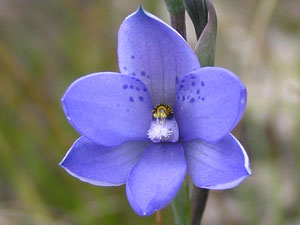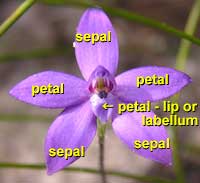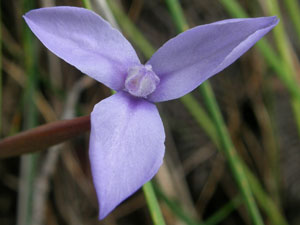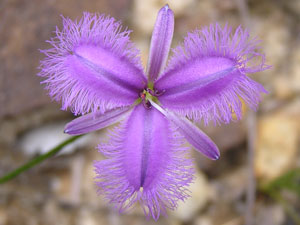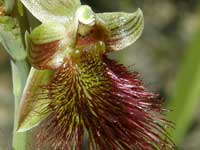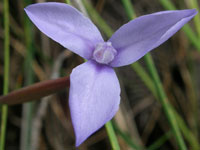We acknowledge the traditional custodians of the land on which these plants grow - the Darug and Gundungurra people - and pay respect to their Elders past, present and emerging.
In dividing the flora of the Blue Mountains into groups to facilitate identification and simplify presentation, it was natural to chose botanic families of orchids, irises and lilies that primarily belong to the Asparagales order.
It should be noted that the genus, family and order a plant belongs to is not static. As recently as 40 years ago the lily family (Liliaceae) had 300 genera and 4,500 species worldwide. It now has 15 genera and 700 species with no species indigenous to Australia.
The new families that were once in the Liliaceae family are presented below.
Including all species from the Asparagales order also introduces some strange bedfellows - like the Lomandra (mat-rushes) and Xanthorrhoea (grass trees) genera. But by and large this grouping works.
There's over 200 species of the Asparagales order in the Blue Mountains.
The outer 3 segments are the sepals; and inner three segments are the petals.
The third petal becoming a lip or labellum.
There are well over 130 species of the Orchidaceae family in the Blue Mountains across 30 genera - but it is volatile as new species and species new to the area are being discovered, and species and genera are being reclassified. Hybrids also abound.
There's some 20 species in the Blue Mountains, but with the exception of six Patersonia and Libertia species, all are introduced.
The more common families found in the Blue Mountains, and a "representative", are -
* grass trees (Xanthorrhoea genus) and Christmas bells (Blandfordia genus) are endemic to Australia.
There's some 60 species of these families found in the Blue Mountains.
- Caladenia carnea
- Caladenia fuscata
- Caleana major
- Calochilus paludosus
- Cryptostylis subulata
- Cyanicula caerulea
- Pterostylis chocolatina
- Prasophyllum elatum
- Pterostylis nutans
- Thelymitra ixioides
- Thelymitra pauciflora
Orchids - family Orchidaceae.
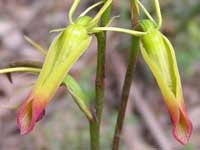
Large Tongue Orchid
Cryptostylis subulata
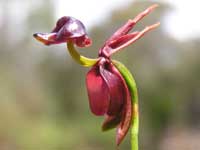
Large Duck Orchid
Caleana major
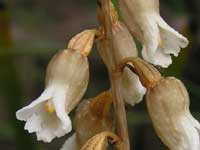
Native Potato
Gastrodia sesamoides
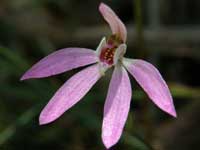
Pink Fingers
Caladenia carnea
Here is an image showing its distinguishing characteristics.
just what the amateur
botanist wants to hear ...
C. catenata isn't found in the Upper Blue Mountains, and as far as I can ascertain -
- C. carnea's labellum lobe doesn't protrude, its labellum tip is yellow and it tends to be pinker.
- C. fuscata's labellum lobe protrudes and its labellum tip is white, and it is smaller.
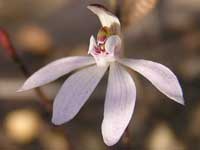
Dusky Fingers
Caladenia fuscata
Here is an image showing its distinguishing characteristics.
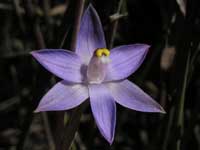
Slender Sun Orchid
Thelymitra pauciflora
Here's a paler form.
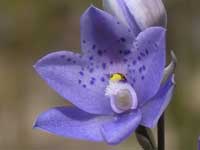
Spotted Sun Orchid
Thelymitra ixioides
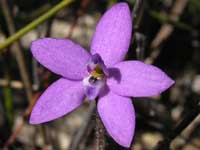
Small Waxlip Orchid
Glossodia minor
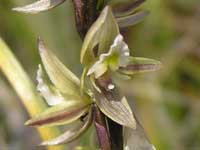
Tall Leek Orchid
Prasophyllum elatum
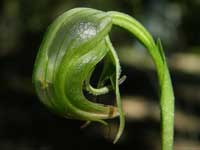
Nodding Greenhood Orchid
Pterostylis nutans
The 3-6 leaves of its rosette have scalloped edges.
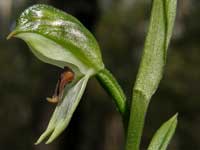
Chocolate-Lip Leafy Greenhood
Pterostylis chocolatina
The Tall Greenhood's labellum is also hairy. There's no rosette.
The Leafy Greenhoods have been placed in a new genera - Bunochilus
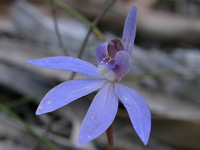
Eastern Tiny Blue
China Orchid
Cyanicula caerulea
It is the only Cyanicula species in NSW.
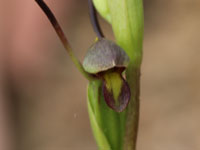
Bird's-mouth Orchid
Orthoceras strictum
Although the plant is about 50cm tall, its colours camouflage it well.
Here's another image.
In NSW, there are 4 species of the Patersonia genus, all are found in the Blue Mountains.
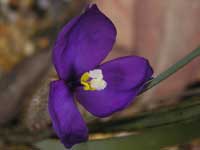
Dwarf Purple Flag
Patersonia sericea var. longifolia
The flowers also seem to be a deeper purple.
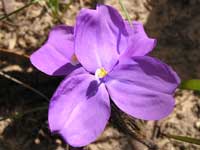
Silky Purple Flag
Patersonia sericea
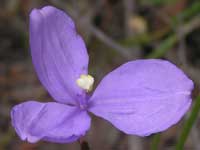
Leafy Purple Flag
Patersonia glabrata
are borne on a stem.
Like its siblings, its flowers last barely a day.
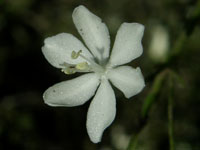
Pretty Grass-flag
Libertia pulchella
Distinguished from the Branching Grass-flag (L. paniculata) as that plant's leaves are longer than its scape* and its pedicels (stalks) are only 1cm long.
This is shown in the full image of the Pretty Grass-flag, and this image showing its 3cm long pedicels.
[* scape - the stem-like flowering stalk.]
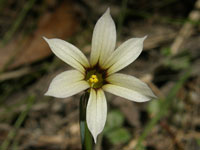
Blue Pigroot
Sisyrinchium micranthum
It has distinctive seed capsules that are 6mm in diameter.
- Agapanthus *
- Alania cunninghamii
- Branching Fringe Lily
- Common Fringe Lily
- Fish Bones
- Golden Weather-grass
- Grape Hyacinth *
- Agapanthus praecox subsp. orientalis *
- Alania cunninghamii
- Arthropodium fimbriatum
- Blandfordia cunninghamii
- Hypoxis hygrometrica
- Sowerbaea juncea
- Thelionema caespitosum
- Thelionema umbellatum
- Thysanotus juncifolius
- Thysanotus tuberosus subsp. tuberosus
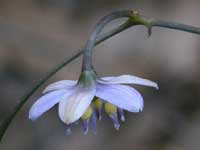
Nodding Chocolate Lily
Arthropodium fimbriatum
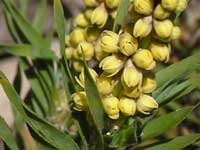
Fish Bones
Lomandra obliqua
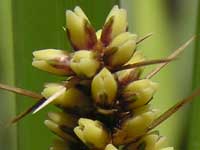
Spiny-headed Mat-rush
Lomandra longifolia
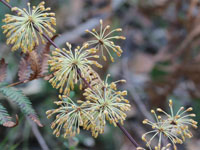
Many-flowered Mat-rush
Lomandra multiflora subsp. multiflora
Here's a close-up of its inflorescence - which is 3cm across.
Here's another image of the plant.
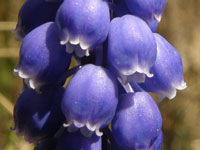
Grape Hyacinth
Muscari armeniacum
It is the only species of this genus in NSW.
Here's another image.
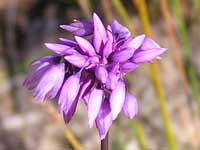
Rush Lily
Sowerbaea juncea
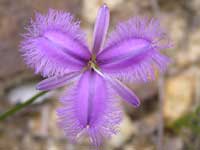
Branching Fringe Lily
Thysanotus juncifolius
Distinguished from the Common Fringe Lily (T. tuberosus) by the absence of basal leaves - as this image shows.
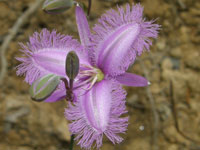
Common Fringe Lily
Thysanotus tuberosus subsp. tuberosus
There are three species in the Thelionema genus, two are found in the Blue Mountains.
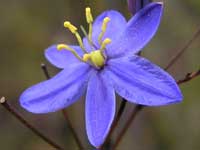
Tufted Blue Lily
Thelionema caespitosum
The flowers are 25mm across and appear in spring and summer.
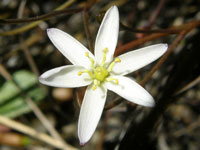
Lemon Flax Lily
Thelionema umbellatum
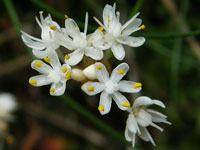
Alania cunninghamii
It is the only species in the genus and the only species in this family in NSW.
Here's another image showing its leaves.
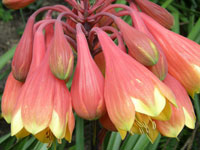
Mountain Christmas Bell
Blandfordia cunninghamii
It grows along cliff edges in early summer.
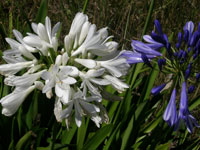
Agapanthus
Agapanthus praecox subsp. orientalis
Its tuberous rootstock is hard to completely remove. Here's an image of its leaves.
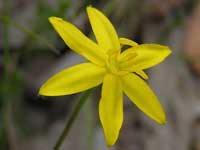
Golden Weather-grass
Hypoxis hygrometrica

